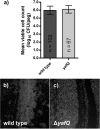The chromosomal toxin gene yafQ is a determinant of multidrug tolerance for Escherichia coli growing in a biofilm
- PMID: 19307375
- PMCID: PMC2687228
- DOI: 10.1128/AAC.00043-09
The chromosomal toxin gene yafQ is a determinant of multidrug tolerance for Escherichia coli growing in a biofilm
Abstract
Escherichia coli is refractory to elevated doses of antibiotics when it is growing in a biofilm, and this is potentially due to high numbers of multidrug-tolerant persister cells in the surface-adherent population. Previously, the chromosomal toxin-antitoxin loci hipBA and relBE have been linked to the frequency at which persister cells occur in E. coli populations. In the present study, we focused on the dinJ-yafQ-encoded toxin-antitoxin system and hypothesized that deletion of the toxin gene yafQ might influence cell survival in antibiotic-exposed biofilms. By using confocal laser scanning microscopy and viable cell counting, it was determined that a Delta yafQ mutant produced biofilms with a structure and a cell density equivalent to those of the parental strain. In-depth susceptibility testing identified that relative to wild-type E. coli, the Delta yafQ strain had up to a approximately 2,400-fold decrease in cell survival after the biofilms were exposed to bactericidal concentrations of cefazolin or tobramycin. Corresponding to these data, controlled overexpression of yafQ from a high-copy-number plasmid resulted in up to a approximately 10,000-fold increase in the number of biofilm cells surviving exposure to these bactericidal drugs. In contrast, neither the inactivation nor the overexpression of yafQ affected the tolerance of biofilms to doxycycline or rifampin (rifampicin). Furthermore, deletion of yafQ did not affect the tolerance of stationary-phase planktonic cells to any of the antibacterials tested. These results suggest that yafQ mediates the tolerance of E. coli biofilms to multiple but specific antibiotics; moreover, our data imply that this cellular pathway for persistence is likely different from that of multidrug-tolerant cells in stationary-phase planktonic cell cultures.
Figures






Similar articles
-
Role of Toxin-Antitoxin-Regulated Persister Population and Indole in Bacterial Heat Tolerance.Appl Environ Microbiol. 2020 Aug 3;86(16):e00935-20. doi: 10.1128/AEM.00935-20. Print 2020 Aug 3. Appl Environ Microbiol. 2020. PMID: 32503909 Free PMC article.
-
Toxin YafQ Reduces Escherichia coli Growth at Low Temperatures.PLoS One. 2016 Aug 24;11(8):e0161577. doi: 10.1371/journal.pone.0161577. eCollection 2016. PLoS One. 2016. PMID: 27557125 Free PMC article.
-
Toxin YafQ increases persister cell formation by reducing indole signalling.Environ Microbiol. 2015 Apr;17(4):1275-85. doi: 10.1111/1462-2920.12567. Epub 2014 Aug 8. Environ Microbiol. 2015. PMID: 25041421
-
Multidrug tolerance of biofilms and persister cells.Curr Top Microbiol Immunol. 2008;322:107-31. doi: 10.1007/978-3-540-75418-3_6. Curr Top Microbiol Immunol. 2008. PMID: 18453274 Review.
-
Persister cells and the riddle of biofilm survival.Biochemistry (Mosc). 2005 Feb;70(2):267-74. doi: 10.1007/s10541-005-0111-6. Biochemistry (Mosc). 2005. PMID: 15807669 Review.
Cited by
-
Integrative biology of persister cell formation: molecular circuitry, phenotypic diversification and fitness effects.J R Soc Interface. 2022 Sep;19(194):20220129. doi: 10.1098/rsif.2022.0129. Epub 2022 Sep 14. J R Soc Interface. 2022. PMID: 36099930 Free PMC article. Review.
-
Phenotypic heterogeneity in bacteria: the rise of antibiotic persistence, clinical implications, and therapeutic opportunities.Arch Microbiol. 2024 Oct 26;206(11):446. doi: 10.1007/s00203-024-04173-3. Arch Microbiol. 2024. PMID: 39460765 Review.
-
Type I toxin-antitoxin systems in bacteria: from regulation to biological functions.EcoSal Plus. 2024 Dec 12;12(1):eesp00252022. doi: 10.1128/ecosalplus.esp-0025-2022. Epub 2024 May 20. EcoSal Plus. 2024. PMID: 38767346 Free PMC article. Review.
-
Surviving as a Community: Antibiotic Tolerance and Persistence in Bacterial Biofilms.Cell Host Microbe. 2019 Jul 10;26(1):15-21. doi: 10.1016/j.chom.2019.06.002. Cell Host Microbe. 2019. PMID: 31295420 Free PMC article. Review.
-
Characterization of Escherichia coli dinJ-yafQ toxin-antitoxin system using insights from mutagenesis data.J Bacteriol. 2012 Mar;194(6):1523-32. doi: 10.1128/JB.06104-11. Epub 2012 Jan 13. J Bacteriol. 2012. PMID: 22247505 Free PMC article.
References
-
- Balaban, N. Q., J. Merrin, R. Chait, L. Kowalik, and S. Leibler. 2004. Bacterial persistence as a phenotypic switch. Science 305:1622-1625. - PubMed
-
- Bigger, J. W. 1944. Treatment of staphylococcal infections with penicillin. Lancet ii:497-500.
Publication types
MeSH terms
Substances
LinkOut - more resources
Full Text Sources
Other Literature Sources
Molecular Biology Databases
Research Materials

